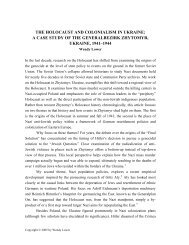Effects of Teachers' Mathematical Knowledge for Teaching on - Apple
Effects of Teachers' Mathematical Knowledge for Teaching on - Apple
Effects of Teachers' Mathematical Knowledge for Teaching on - Apple
You also want an ePaper? Increase the reach of your titles
YUMPU automatically turns print PDFs into web optimized ePapers that Google loves.
Student Background<br />
Several student background measures were included in this study. Students’<br />
rate <str<strong>on</strong>g>of</str<strong>on</strong>g> absence from mathematics instructi<strong>on</strong> was generated by aggregating<br />
log reports <str<strong>on</strong>g>of</str<strong>on</strong>g> daily student absences to the student level. Just over nine logs<br />
were recorded <str<strong>on</strong>g>for</str<strong>on</strong>g> the average first grader and eight logs <str<strong>on</strong>g>for</str<strong>on</strong>g> the average<br />
third grader, and the reliability <str<strong>on</strong>g>of</str<strong>on</strong>g> this aggregated estimate in discriminating<br />
am<strong>on</strong>g students’ rate <str<strong>on</strong>g>of</str<strong>on</strong>g> absence was .41. Using these data, we created a<br />
dummy variable representing students whose absence rate exceeded 20%<br />
(the reference category being students with less than a 20% absence rate).<br />
In<str<strong>on</strong>g>for</str<strong>on</strong>g>mati<strong>on</strong> <strong>on</strong> students’ gender and minority status was collected from<br />
teachers and other school pers<strong>on</strong>nel at the time <str<strong>on</strong>g>of</str<strong>on</strong>g> student sampling. In<str<strong>on</strong>g>for</str<strong>on</strong>g>mati<strong>on</strong><br />
<strong>on</strong> family SES was collected via teleph<strong>on</strong>e interviews with the parents<br />
or legal guardian <str<strong>on</strong>g>of</str<strong>on</strong>g> the study students. The composite SES variable<br />
represented an average <str<strong>on</strong>g>of</str<strong>on</strong>g> father’s and mother’s educati<strong>on</strong> level, their occupati<strong>on</strong><br />
level, and family income.<br />
Teacher Background and Classroom Characteristics<br />
The primary source <str<strong>on</strong>g>of</str<strong>on</strong>g> data <strong>on</strong> teacher background variables was the teacher<br />
questi<strong>on</strong>naire, from which in<str<strong>on</strong>g>for</str<strong>on</strong>g>mati<strong>on</strong> was used to c<strong>on</strong>struct measures <str<strong>on</strong>g>of</str<strong>on</strong>g><br />
teacher experience, certificati<strong>on</strong>, and undergraduate/graduate coursework.<br />
These teacher background characteristics were straight<str<strong>on</strong>g>for</str<strong>on</strong>g>wardly represented<br />
in our statistical models. For instance, teachers’ experience was reported as<br />
number <str<strong>on</strong>g>of</str<strong>on</strong>g> years in service at Year 2 <str<strong>on</strong>g>of</str<strong>on</strong>g> the study. Although we had in<str<strong>on</strong>g>for</str<strong>on</strong>g>mati<strong>on</strong><br />
<strong>on</strong> n<strong>on</strong>certified teachers’ credentials (e.g., provisi<strong>on</strong>al or emergency<br />
certificati<strong>on</strong>), too few teachers existed in each such category to include them<br />
independently in statistical analyses; thus, our credential variable simply represented<br />
the presence (coded as 1) or absence (coded as 0) <str<strong>on</strong>g>of</str<strong>on</strong>g> certificati<strong>on</strong>.<br />
Finally, teachers reported the total number <str<strong>on</strong>g>of</str<strong>on</strong>g> mathematics methods and<br />
mathematics c<strong>on</strong>tent courses taken as part <str<strong>on</strong>g>of</str<strong>on</strong>g> their preservice and postgraduate<br />
higher educati<strong>on</strong>. Because reports <str<strong>on</strong>g>of</str<strong>on</strong>g> methods courses and reports<br />
<str<strong>on</strong>g>of</str<strong>on</strong>g> c<strong>on</strong>tent courses were highly correlated (r = .80), they led to multicollinearity<br />
in regressi<strong>on</strong> models estimated during both the first and third<br />
grades. As a result, we <str<strong>on</strong>g>for</str<strong>on</strong>g>med a single measure combining reports <str<strong>on</strong>g>of</str<strong>on</strong>g> mathematics<br />
methods and c<strong>on</strong>tent coursework. Un<str<strong>on</strong>g>for</str<strong>on</strong>g>tunately, this strategy did<br />
not allow <str<strong>on</strong>g>for</str<strong>on</strong>g> an examinati<strong>on</strong> <str<strong>on</strong>g>of</str<strong>on</strong>g> the independent effects <str<strong>on</strong>g>of</str<strong>on</strong>g> methods and c<strong>on</strong>tent<br />
courses, as is standard practice in the educati<strong>on</strong>al producti<strong>on</strong> functi<strong>on</strong><br />
literature (e.g., M<strong>on</strong>k, 1994).<br />
We included three classroom variables in our analyses. First, in<str<strong>on</strong>g>for</str<strong>on</strong>g>mati<strong>on</strong><br />
<strong>on</strong> percentage <str<strong>on</strong>g>of</str<strong>on</strong>g> minority students was obtained by aggregating student characteristics<br />
<str<strong>on</strong>g>for</str<strong>on</strong>g> each classroom. Sec<strong>on</strong>d, to capture variati<strong>on</strong> in the absolute<br />
amount <str<strong>on</strong>g>of</str<strong>on</strong>g> mathematics instructi<strong>on</strong> to which students were exposed, we developed<br />
a measure <str<strong>on</strong>g>of</str<strong>on</strong>g> average classroom time spent <strong>on</strong> mathematics using data<br />
from teachers’ mathematics logs. The time measure excluded days <strong>on</strong> which<br />
the student or teacher was absent. Finally, rate <str<strong>on</strong>g>of</str<strong>on</strong>g> teacher absence from mathematics<br />
less<strong>on</strong>s was calculated by aggregating logs to the teacher level.<br />
386




